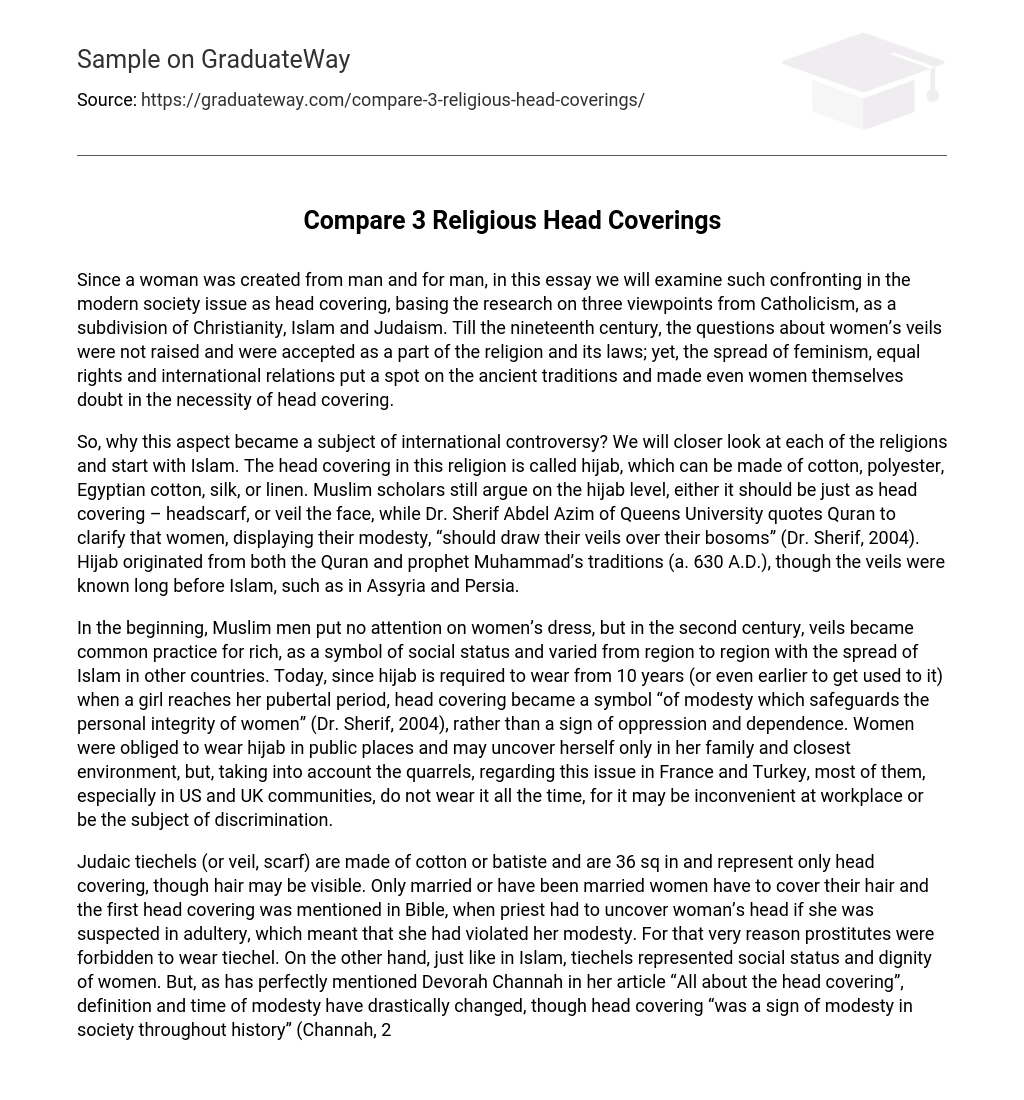Since woman was created from man and for man, this essay will examine the confronting issue of head covering in modern society. We will base our research on three viewpoints: Catholicism (as a subdivision of Christianity), Islam, and Judaism. Until the nineteenth century, questions about women’s veils were not raised and were accepted as part of religion and its laws. However, the spread of feminism, equal rights, and international relations has shed light on ancient traditions and made even women themselves doubt the necessity of head covering.
So, why has this aspect become a subject of international controversy? Let’s take a closer look at each religion, starting with Islam. In this religion, the head covering is called hijab and can be made of cotton, polyester, Egyptian cotton, silk or linen. Muslim scholars still argue about the level of hijab required – whether it should just be a head covering (headscarf) or also veil the face. However, Dr. Sherif Abdel Azim of Queens University quotes the Quran to clarify that women displaying their modesty should draw their veils over their bosoms” (Dr. Sherif, 2004). The origins of hijab come from both the Quran and Prophet Muhammad’s traditions (around 630 A.D.), although veils were known long before Islam in places such as Assyria and Persia.
Initially, Muslim men paid little attention to women’s dress. However, in the second century, veils became a common practice among the wealthy as a symbol of social status. The style of veiling varied from region to region as Islam spread to other countries.
Today, hijab is required for girls to wear from the age of 10 (or even earlier) when they reach puberty. Head covering has become a symbol of modesty which safeguards the personal integrity of women” (Dr. Sherif, 2004), rather than a sign of oppression and dependence.
Women are obliged to wear hijab in public places and may only uncover themselves in their family and closest environments. However, due to disputes regarding this issue in France and Turkey, most women – especially those in US and UK communities – do not wear it all the time because it may be inconvenient at work or be subject to discrimination.
Judaic tiechels, also known as veils or scarves, are typically made of cotton or batiste and measure 36 square inches. They serve as a head covering for married or previously married women, although some hair may still be visible. The tradition of head covering dates back to Biblical times when priests would uncover a woman’s head if she was suspected of adultery, indicating that she had violated her modesty. As a result, prostitutes were forbidden from wearing tiechels.
Similar to Islam, tiechels have historically represented the social status and dignity of women. However, the definition and time period for modesty has changed over time. As Devorah Channah notes in her article All About the Head Covering,” while head covering has been a sign of modesty throughout history, it has evolved with changing societal norms.
During times of international persecution, Jewish women were forced to uncover their heads. Today even the most devout women typically only wear tiechels in synagogues.
Do Catholic women cover their hair, or is it supposed to be a practice from the Apostolic Era based on 1st Corinthians where married women are required to veil themselves, otherwise they must cut off their hair? The veil in Catholic history has varied from mantilla, veil, scarves, hats, coifs, bonnets; in general, it should be a piece of cloth that married or previously married women wear either during Mass or all day long. Nevertheless, some scholars agree that a woman should not wear the veil until her heart is covered. This means that she must accept the place that God gives to women in the Church, the family and society” (Headcovering for Catholic Women). Therefore, the veil in Catholicism represents modesty and obedience and is a differentiating symbol between men’s and women’s roles.
Unlike the aforementioned religions, Christianity, and specifically Catholicism, recognizes that the head covering serves as a symbol of submission with spiritual significance. It aids women in focusing on Christ and following God’s commandments obediently. In contrast, Islam and Judaism emphasize the external aspects of religious identity, modesty, and protection.
References
- Channah, Devorah (2007). All About the Head Covering. Retrieved April 7, 2008, from the Headcoverings by Devorah website: http://www.headcoverings-by-devorah.com/HEADCOVERINGS.htm
- Dr. Sherif Abdel Azim (2004, January 2). Head Covering and the Freedom of Religion. Retrieved April 7, 2008, from the IslamiCity website: http://www.islamicity.com/articles/Articles.asp?ref=IC0301-2178
- Headcovering for Catholic Women (n.d.). Retrieved April 7, 2008, from the Catholic Planet website: http://www.catholicplanet.com/women/headcovering.htm





